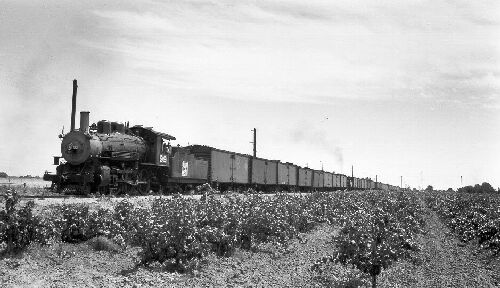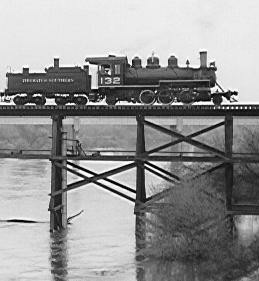
In
The Beginning
 |
| Western Pacific No. 99 rolls Stockton-bound on the Tidewater Southern at McHenry. During the peak season rush the Tidewater often leased additional power from parent WP in order to keep traffic fluid. (Guy Dunscomb Photo - Rattenne Collection) |
Western Pacific Needs You!
 When
the Western Pacific Railway was incorporated in 1906 it's charter
specifically stated that the new transcontinental railroad was to be built
sans branchlines: Mainline construction between Oakland and Salt Lake City
was the only object of WP's financier, Jay Gould. Put
simply, WP was conceived as a pipeline for Gould's East Coast-originated
traffic, to be handed over to the company by Gould-owned Rio Grande at
Salt Lake City. WP was to be a bridge route in the strictest sense!
When
the Western Pacific Railway was incorporated in 1906 it's charter
specifically stated that the new transcontinental railroad was to be built
sans branchlines: Mainline construction between Oakland and Salt Lake City
was the only object of WP's financier, Jay Gould. Put
simply, WP was conceived as a pipeline for Gould's East Coast-originated
traffic, to be handed over to the company by Gould-owned Rio Grande at
Salt Lake City. WP was to be a bridge route in the strictest sense!
| This limitation became an extreme
burden to the company almost immediately, though, as originating traffic
was limited mostly to the West Coast (San Francisco and Oakland).
By 1916 it was apparent to existing management that if Western Pacific did not acquire online resources it could not generate enough revenue to pay the bills. In fact, WP defaulted on its loan payments that year and was sold at auction from its own Oakland depot. Between 1916 and 1932 the reorganized Western Pacific Railroad purchased fractional interests in, or bought outright, eight different shortlines, amongst them a small interurban company called the Tidewater Southern. WP purchased a 75% controlling interest in 1917, and that year the Tidewater began contributing traffic and revenue to its parent company while maintaining a separate corporate identity. Up until merger with the Union Pacific Railroad on December 22, 1982, Tidewater Southern crews had their own seniority list and were called for jobs separately from WP crews in Stockton. Immediately after the merger, though eventually TS crews were merged into the seniority list of former WP engine and train crews. On merger day in 1982 the TS became a paper railroad like its parent WP and sister subsidiary Sacramento Northern. On June 17, 1987, the railroad officially became a fallen flag: The Western Pacific, Sacramento Northern and Tidewater Southern all disappeared on that day, no longer existing in reality or on paper. |

Tidewater
Southern's lone surviving steam engine crosses the Tuolumne River bridge
in Modesto in 1952. (Will Whitaker Photo - Rattenne Collection)
|